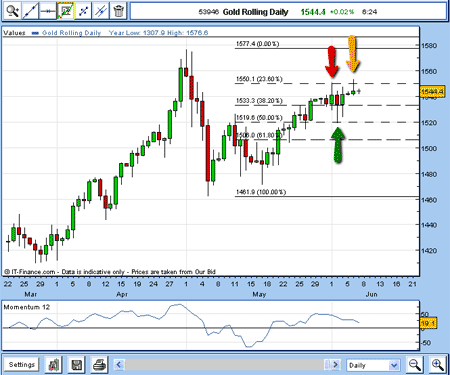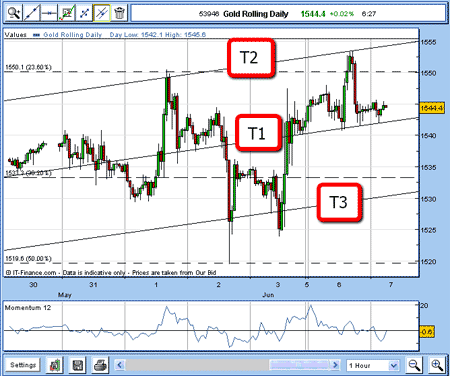Four key trading lessons that will keep you in the game
Following Monday's continued rally in the gold market, John C Burford sees his short trade end at the break-even point. Now, he draws fresh tramlines to reenter the market and makes four important conclusions to keep you in the game.
In my last post, I outlined the reasons why I shorted gold last week at $1,550.
They were very convincing reasons, even if I say so myself.
The problem was, the market didn't agree with me.
MoneyWeek
Subscribe to MoneyWeek today and get your first six magazine issues absolutely FREE

Sign up to Money Morning
Don't miss the latest investment and personal finances news, market analysis, plus money-saving tips with our free twice-daily newsletter
Don't miss the latest investment and personal finances news, market analysis, plus money-saving tips with our free twice-daily newsletter
But the way the trade evolved highlights several very important principles for anyone who trades or invests. I will list a few, after I have analysed the trade.
Right after my entry, the market did fall away from the Fibonacci 76.4% retrace level at $1,550 and moved down to $1,520 (the Fibonacci 50% level).
I have found that on pull-backs such as this one, the previous Fibonacci levels can act as support, which can be weak or strong. And the 50% level is particularly significant.
So, I had a $30 'gain' right away. And here is where my break-even rule proved its worth.
I moved my protective stop down to $1,550 at break-even. So whatever happens, I will not lose money on this trade. How's that for peace of mind?
Here is the chart as of yesterday morning (Tuesday 7 June):

(Clickon thechart for a larger version)
I have marked my entry short sale at $1,550 with a red arrow, and the decline to support at the Fibonacci 50% level at $1,520 with a green arrow.
And would you believe it on Monday, the market continued Friday's rally to take me out of my trade at $1,550 (yellow arrow). No win and no loss. And my capital is intact.
Spotting tramlines in the gold market
But take a look at the hourly chart:

(Clickon thechart for a larger version)
Right away, I can spot a line of support along Monday's minor lows and this morning in the $1,540 $1,542 area. So I decided to look for tramlines!
I found that if I draw my first line along these lows, it passes through the low of 30 May. This will be my first tramline, T1.
To find my upper tramline, I draw a parallel line and it passes through the important tops made 1 and 6 June. That's good and is my T2.
Incidentally, if you continue T1 back to 24-26 May, you will find it passes across a few important minor highs. That adds to its validity.
But I am content to be out of the market here, as there is always another trade coming along.
And to finish my tramlines, I then draw T3 equidistant beneath T1, just in case the market agrees with my bearish scenario and heads below T1.
Since T1 is acting as support, any break of this line would be bearish and I can expect a fall to T3 at least.
So far, the support is holding and the market remains in a rally phase.
But these markets can turn on a sixpence, so I will place a sell order to enter just below T1 using a protective stop of about $5 above my entry using my 3% rule.
Of course, the market may continue rising past the $1,550 area again to make new highs. It has already made two attempts to get past this level, and has failed (so far). But a third attempt may succeed after all, it is rare that third attempts fail.
So, here are the important principles to take away from this trade:
1.Because the markets are probabilistic, there is a real possibility that your reasoned analysis will be wrong. So don't get married to a particular view until the market confirms it. And even then, be alert for disappointments. This applies especially when following received wisdom (trading with the herd). Most of us get so caught up in the fervor of a viewpoint that we miss the turning points.
2.Using my break-even rule can bring peace of mind, knowing that your trade will not dent your account balance. Being in a stress-free state is the place to trade from.
3.Keeping your capital intact is, for me, paramount. That means, do not over-trade, and keep things simple.
4.Do not fight the market. This trade was stopped out on a rally continuation. The market was telling me something that it doesn't like my bearish stance, at least in the short-term.
Above all, have some fun. Trading should not be all serious!
NB: Don't miss my next trading insight. To receive all my spread betting blog posts by email, as soon as I've written them, just sign up here .
Get the latest financial news, insights and expert analysis from our award-winning MoneyWeek team, to help you understand what really matters when it comes to your finances.
John is is a British-born lapsed PhD physicist, who previously worked for Nasa on the Mars exploration team. He is a former commodity trading advisor with the US Commodities Futures Trading Commission, and worked in a boutique futures house in California in the 1980s.
He was a partner in one of the first futures newsletter advisory services, based in Washington DC, specialising in pork bellies and currencies. John is primarily a chart-reading trader, having cut his trading teeth in the days before PCs.
As well as his work in the financial world, he has launched, run and sold several 'real' businesses producing 'real' products.
-
 ‘Why I have ditched my Help to Buy ISA for cash savings and the stock market’
‘Why I have ditched my Help to Buy ISA for cash savings and the stock market’Without the 25% bonus, my Help to Buy ISA is effectively redundant, says MoneyWeek writer Sam Walker.
-
 Is your inheritance tax allowance cut if you sell to downsize or sell your home to pay for care?
Is your inheritance tax allowance cut if you sell to downsize or sell your home to pay for care?Downsizing relief is a little-known benefit that could save your loved ones tens of thousands of pounds in inheritance tax after you’ve died.